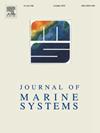Nutrient variability drivers in shallow coastal waters of the Eastern Arabian Sea during winter monsoon with implications for coastal productivity
IF 2.5
3区 地球科学
Q2 GEOSCIENCES, MULTIDISCIPLINARY
引用次数: 0
Abstract
The Eastern Arabian Sea (EAS) exhibits complex nutrient variability driven by seasonal monsoon dynamics and hydrographic processes. This study investigates the spatial distribution of dissolved inorganic nutrients (DIN, DIP, and DSi), hydrographic conditions, and primary productivity in shallow coastal waters of this region during the winter monsoon of 2019. Our findings reveal regional contrasts, with the North-Eastern Arabian Sea (NEAS) experiencing cooler, nutrient-enriched waters due to convective mixing, supporting higher chlorophyll biomass, whereas the South-Eastern Arabian Sea (SEAS) remains warmer with limited nutrient flux. The coexistence of nutrient maxima and temperature minima in the surface coastal waters of north-eastern region further supports the efficient transport of cooler, nutrient-rich waters to the surface. Nutrient stoichiometry indicates nitrogen limitation in the SEAS and silicate-fuelled productivity in the NEAS. Chlorophyll-a (Chl-a) concentrations were significantly higher in the north-eastern region, reflecting enhanced surface productivity. Dissolved inorganic carbon (DIC) and partial pressure of CO₂ (pCO₂) analyses highlight the supersaturated state of CO2 in this region, likely driven by convective overturning. Principal component analysis underscores the critical role of temperature, salinity, and mixing in shaping nutrient dynamics and carbon flux. These findings emphasize the need for sustained observation to predict the ecosystem's response to climatic variability and anthropogenic influences, making this study a valuable reference for understanding coastal productivity in monsoon-driven systems.
冬季季风期间东阿拉伯海浅海沿岸水域的营养变化驱动因素及其对沿海生产力的影响
东阿拉伯海(EAS)表现出由季节季风动力学和水文过程驱动的复杂的营养变化。研究了2019年冬季季风期间该地区浅海近岸水域溶解无机营养物(DIN、DIP和DSi)的空间分布、水文条件和初级生产力。我们的研究结果揭示了区域差异,由于对流混合,东北阿拉伯海(NEAS)经历了更冷、营养丰富的水域,支持更高的叶绿素生物量,而东南阿拉伯海(SEAS)保持温暖,营养通量有限。东北沿海表层水体中营养最大值和温度最小值的共存,进一步支持了较冷、营养丰富的水体向表层的有效输送。营养化学计量学表明,海洋的氮含量有限,而东北沿海地区的硅酸盐燃料生产力有限。东北地区叶绿素-a (Chl-a)浓度显著升高,反映了地表生产力的增强。溶解无机碳(DIC)和CO₂分压(pCO₂)分析强调了该地区CO2的过饱和状态,可能是由对流翻转驱动的。主成分分析强调了温度、盐度和混合在形成养分动态和碳通量中的关键作用。这些发现强调需要持续观测来预测生态系统对气候变率和人为影响的响应,使本研究成为了解季风驱动系统中沿海生产力的有价值参考。
本文章由计算机程序翻译,如有差异,请以英文原文为准。
求助全文
约1分钟内获得全文
求助全文
来源期刊

Journal of Marine Systems
地学-地球科学综合
CiteScore
6.20
自引率
3.60%
发文量
81
审稿时长
6 months
期刊介绍:
The Journal of Marine Systems provides a medium for interdisciplinary exchange between physical, chemical and biological oceanographers and marine geologists. The journal welcomes original research papers and review articles. Preference will be given to interdisciplinary approaches to marine systems.
 求助内容:
求助内容: 应助结果提醒方式:
应助结果提醒方式:


